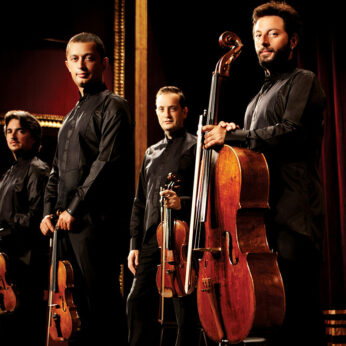Composer: Peteris Vasks (b. 1946)
Performance date: 28/06/2019
Venue: Bantry Library
Composition Year: 1999
Duration: 00:31:58
Recording Engineer: Ciaran Cullen, RTÉ
Instrumentation: 2vn, va, vc
Instrumentation Category:String Quartet
Artists:
Borusan Quartet (Esen Kıvrak, Özgür Baskin [violins], Efdal Altun [viola], Cağ Ercağ, [cello]) -
[quartet]

Peteris Vasks [born 1946]
String Quartet No.4 [1999]
1. Elegy
2. Toccata I
3. Choral
4. Toccata II
5. Meditation
When I think about contemporary life it’s impossible not to realise that we are balanced on the edge of time’s end. It’s frighteningly close. But is there any point to composing a piece that only mirrors our being one step away from extinction? To my mind, every honest composer searches for a way out of his time’s crises – towards affirmation, towards faith. He shows how humanity can overcome this passion for self-annihilation that flares up in a column of black smoke from time to time.
– Peteris Vasks
Vasks composed this quartet in the last year of the old century to celebrate the 90th birthday of his mother, who had lived through the extraordinary upheavals the 20th century had brought to Latvia, a front-line in two world wars. The Quartet was premiered in the Theatre de la Ville in Paris in May 2000 and was premiered in Ireland, here in Bantry House, in 2004. Its structure echoes the palindrome-like form of Bartók’s Fifth Quartet, with first, third and fifth movements reflecting each other while the second and fourth make a pair.
The Elegy comes from nowhere and slowly establishes a contemplative atmosphere with a line of bird-like trills, occasionally startling the ear with a quick descending glissando. Vasks describes the Elegy as an encounter with the past with music that is plaintive but not laconic, driving forwards towards something as yet unknown. The dynamic changes give a sense of rising and falling, of an unknown future.
In violent contrast the first Toccata begins with brutal chords, accentuated rhythms and brazen harmonies vividly and inevitably reminding us of the anger and fury in the corresponding movement in Shostakovich’s Eighth . Syncopated accents in the rhythm create a furious tension as this short movement simultaneously agitates and enthrals before heading attacca straight into the Choral’s long lament. The pace slows but the passionate clashes between the parts as they ascend through the sequence at different paces and harmonic dissonances convey Vasks’ melancholy and the diversity of textures and rising modulations draw the listener deep into the music. The climbing arc of the melodies express hope pushing itself up and out from the gloom. This central movement climaxes in a series of unresolved chords before slowly sinking and the violence of the second Toccata takes over.
This mirrors the second movement, using accentuated rhythms and striking harmonies to drive the music forward. The most fascinating compositional device is the extended group ascending glissando that seems to create an effect of the music swirling around our heads, evincing chaos and confusion. This movement ends as abruptly as it began with short accented notes, almost jolting the listener backwards, as if the music wanted to rush on forwards but was being halted in its tracks.
Meditation sees the ecstatic song of the violin soaring above the earthbound melody in the lower strings until its descending glissando brings the song to earth as the music momentarily darkens before the violin soars again. The composer has written of this moment: I saw an angel flying over the world looking at the world’s condition with grieving eyes. Bird’s wings, angel’s wings have always been a symbol of hope, listen carefully and you will hear them.
Copyright © 2025 West Cork Music. All rights reserved.
Designed and developed by Matrix Internet